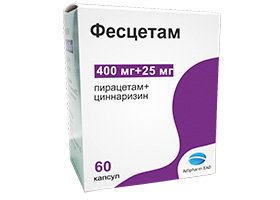
All iLive content is medically reviewed or fact checked to ensure as much factual accuracy as possible.
We have strict sourcing guidelines and only link to reputable media sites, academic research institutions and, whenever possible, medically peer reviewed studies. Note that the numbers in parentheses ([1], [2], etc.) are clickable links to these studies.
If you feel that any of our content is inaccurate, out-of-date, or otherwise questionable, please select it and press Ctrl + Enter.
Fescetam
Medical expert of the article
Last reviewed: 04.07.2025

Fescetam is a nootropic drug with psychostimulant activity. It contains piracetam and cinnarizine.
The complex therapeutic agent has a pronounced antihypoxic effect. Each of its active components mutually enhances the medicinal effects, which are aimed at reducing vascular resistance. Thanks to the combination of therapeutic components, blood circulation processes inside the brain are enhanced.
ATC classification
Active ingredients
Pharmacological group
Pharmachologic effect
Indications Fescetam
It is used in case of blood flow disorders inside the brain:
- atherosclerosis, affecting the cerebral vessels, against the background of which ischemic stroke is observed, or which appears during follow-up treatment after the development of hemorrhagic stroke;
- after TBI;
- disorders of thought, memory and concentration;
- mood disorders (feeling irritable or depressed);
- encephalopathy of various origins;
- labyrinthopathy of various origins (ear noise, vomiting, dizziness, nausea and nystagmus);
- Meniere's disease;
- prevention of development of kinetic diseases;
- prevention of migraines;
- improving memory and learning processes in children with mental retardation.
Release form
The medicinal element is released in capsules - 10 pieces inside a cellular package. The pack contains 6 such packages.
Pharmacodynamics
Piracetam helps improve cholinergic, GABAergic, and glutamatergic neurotransmission. At the same time, it simplifies the process of data transmission between the cerebral hemispheres and within them. It also has anti-ischemic properties associated with the impact on metabolic processes and rheological characteristics of the blood.
Cinnarizine is a selective antagonist of H1-endings of histamine and calcium. It has been found that it inhibits the movement of Ca ions through cell walls, inhibits the effect of vasoconstrictor conductors (bradykinin and angiotensin with catecholamines) and has an insignificant vasodilating effect on peripheral, coronary and cerebral vessels. In addition, the substance increases carbon monoxide levels in cerebral blood vessels during metabolic processes and increases cellular resistance to hypoxia. It does not affect the pulse and blood pressure values.
Pharmacokinetics
The complex agent is completely and quickly absorbed within the gastrointestinal tract.
Plasma Cmax values of cinnarizine are observed after 60 minutes from the moment of oral administration. It is completely subject to metabolic processes. It is synthesized with blood intraplasmic protein by 91%. In an unchanged state, 60% of the element is excreted with feces, and the remainder is excreted with urine in the form of metabolic components.
The Cmax values of piracetam inside the plasma are noted after 2-6 hours. The element passes through the BBB without complications. Excretion of the unchanged component occurs with urine.
Dosing and administration
The capsules should be taken orally, after meals; there is no need to chew them – swallow them whole and wash them down with plain water.
Adults take 1-2 capsules 3 times a day (depending on the intensity of the pathology).
Children over 5 years of age should take 1-2 capsules of the medicine, 1-2 times per day.
The therapeutic course lasts for 1-3 months, depending on the severity of the disease. It cannot be taken for more than 3 months.
 [ 1 ]
[ 1 ]
Use Fescetam during pregnancy
Fescetame should not be used during breastfeeding or pregnancy.
Contraindications
Among the contraindications:
- severe intolerance caused by the action of the drug's components;
- severe kidney or liver dysfunction;
- shaking palsy.
Side effects Fescetam
Main side effects:
- allergy symptoms: occasional photophobia, rashes, lichen planus and SLE;
- damage to the digestive function: sometimes there is pain in the epigastric region, mild manifestations of dyspepsia and dryness of the oral mucosa;
- Others: isolated cases of weight gain, irritability, tremors affecting the extremities, headaches and increased muscle tone.
Overdose
Children who are poisoned by the drug may experience euphoria, tremors, irritability, and sleep disorders. Occasionally, nightmares, hallucinations, and convulsions may occur.
Symptomatic measures are carried out.
Interactions with other drugs
Combination with medications that depress the central nervous system, nootropics, alcoholic beverages and antihypertensive drugs may lead to an increase in their sedative properties.
Vasodilator drugs potentiate the activity of Fescetam, while hypertensive drugs, on the contrary, reduce it.
The drug potentiates the effect of thyroid hormones, and is also capable of enhancing the influence of indirect anticoagulants.
Storage conditions
Fescets should be stored in a place closed to children. Temperature values are no more than 25°C.
Shelf life
Fescetam is approved for use for a period of 3 years from the date of manufacture of the drug.
Application for children
It is prohibited to use the medicine for children under 5 years of age.
Analogues
Analogues of the drug are Omaron, Combitropil, Fezam and NooKam with Piracezin.
Manufacturer
Attention!
To simplify the perception of information, this instruction for use of the drug "Fescetam" translated and presented in a special form on the basis of the official instructions for medical use of the drug. Before use read the annotation that came directly to medicines.
Description provided for informational purposes and is not a guide to self-healing. The need for this drug, the purpose of the treatment regimen, methods and dose of the drug is determined solely by the attending physician. Self-medication is dangerous for your health.

